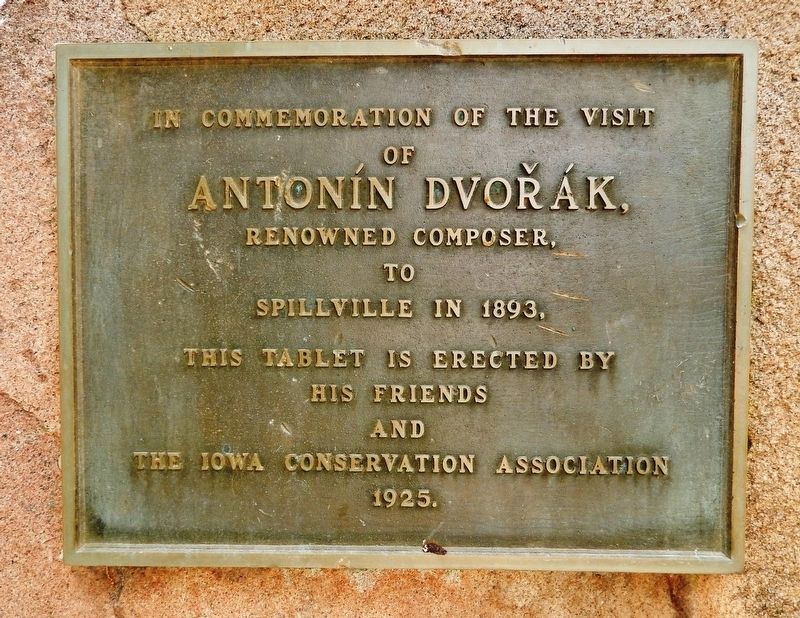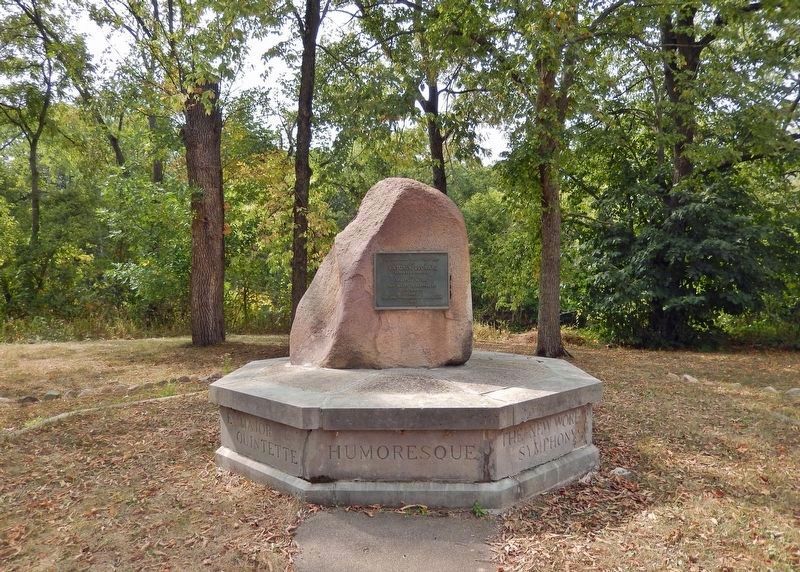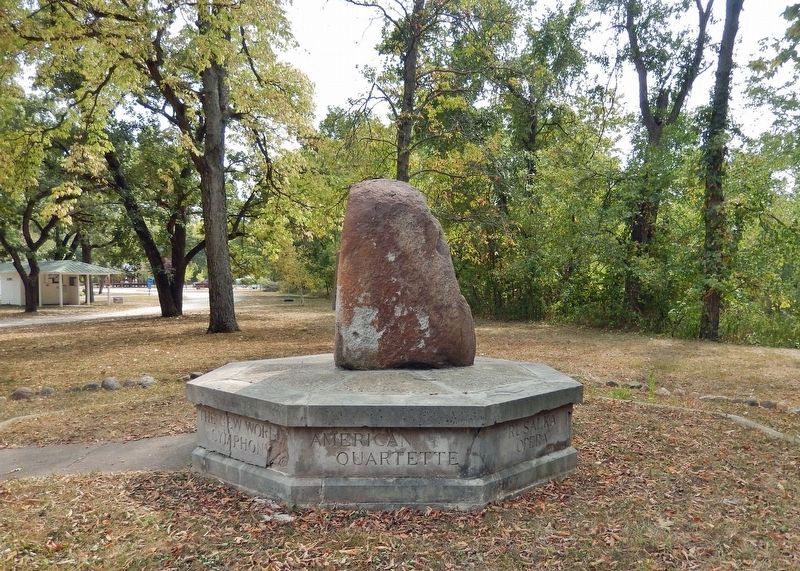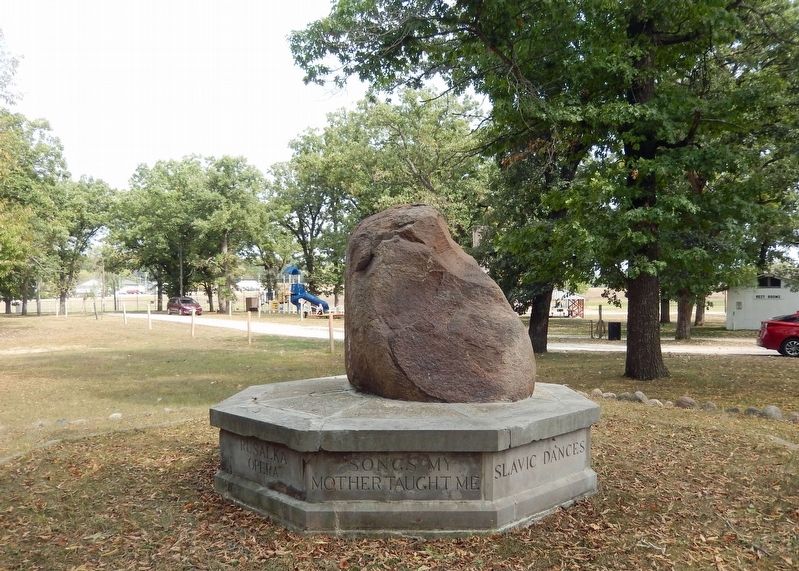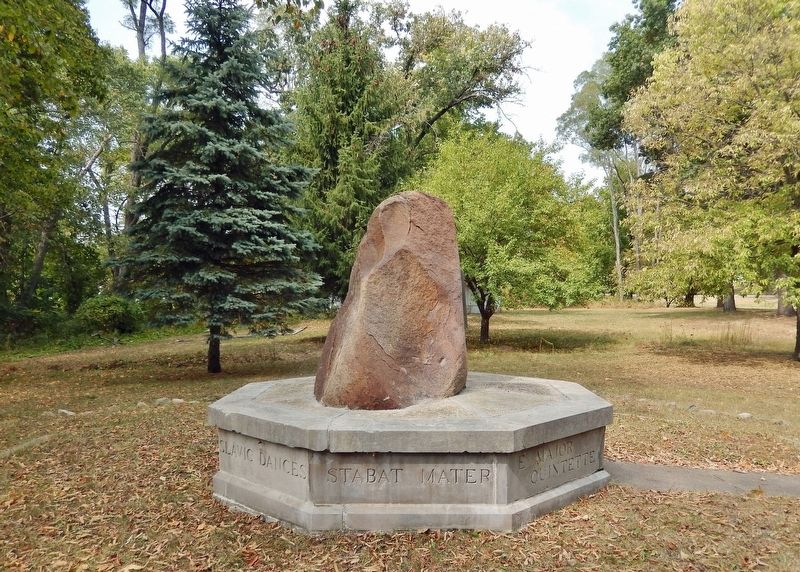Spillville in Winneshiek County, Iowa — The American Midwest (Upper Plains)
Antonín Dvořák
of
Antonín Dvořák
renowned composer,
to
Spillville in 1893,
this tablet is erected by
his friends
and
The Iowa Conservation Association
1925.
Erected 1925 by The Iowa Conservation Association.
Topics. This historical marker is listed in these topic lists: Arts, Letters, Music • Entertainment. A significant historical year for this entry is 1893.
Location. 43° 11.986′ N, 91° 56.846′ W. Marker is in Spillville, Iowa, in Winneshiek County. Marker can be reached from Bridge Street (Dvorak Memorial Highway) (County Highway B16) 0.2 miles east of South Main Street, on the right when traveling east. The marker and memorial are located near the Inwood Ballroom in Riverside Park. Touch for map. Marker is at or near this postal address: 116 Bridge Street, Spillville IA 52168, United States of America. Touch for directions.
Other nearby markers. At least 8 other markers are within 4 miles of this marker, measured as the crow flies. Wenzil Taylor Building (approx. 0.2 miles away); Clarence C. Haug Major General (approx. 0.4 miles away); The Big Stone Mills (approx. half a mile away); Fort Atkinson (approx. 3.8 miles away); Guard House (approx. 3.8 miles away); Sutler's Store and Post Commissary (approx. 3.8 miles away); Constructing Fort Atkinson (approx. 3.8 miles away); North Barracks (approx. 3.8 miles away). Touch for a list and map of all markers in Spillville.
Also see . . .
1. Antonín Dvořák (Wikipedia). Excerpt:
In 1892, Dvořák moved to the United States and became the director of the National Conservatory of Music of America in New York City. The President of the National Conservatory of Music in America, Jeannette Thurber, offered Dvořák an annual salary of $15,000 – an incredibly lavish sum for the era (equivalent to $488,556 in 2022), twenty-five times what he was paid at the Prague Conservatory. While in the United States, Dvořák wrote his two most successful orchestral works: the Symphony From the New World, which spread his reputation worldwide, and his Cello Concerto, one of the most highly regarded of all cello concerti.(Submitted on January 11, 2024, by Cosmos Mariner of Cape Canaveral, Florida.)
In the summer of 1893, Dvořák moved from New York City to Spillville, Iowa, following the advice of his secretary, J.J. Kovarík. Dvořák had originally planned to come back to Bohemia, but Spillville was made up of mostly Czech immigrants, and thus he felt less homesick; Dvořák referred to it as his "summer Vysoka." This is where he wrote his most famous piece of chamber music, his String Quartet in F major, Op. 96, which was later nicknamed the American Quartet. Shortly after his time in Iowa, Dvořák extended his contract at the National Conservatory for another two years. However, the economic crisis of April 1893 resulted in Thurber's husband's loss of income, and directly influenced the National Conservatory's funding. Shortfalls in payment of his salary, along with increasing recognition in Europe and an onset of homesickness, led him to leave the United States and return to Bohemia in 1895.
2. Antonín Dvořák — 1892-95: The American Adventure. Excerpt:
Dvořák spent a total of about twenty-four months in America: three school years in New York from September 1892 through April 1895 plus one long summer vacation period in 1893 in the Czech village of Spillville, Iowa – birthplace of his constant companion throughout the American sojourn, the violinist Josef Kovařík (1870-1951) whom he had met in Prague where he was studying at the conservatory. According to Kovařík’s (perhaps slightly biased) testimony, Dvořák was so enamored of Spillville that he considered settling there permanently, dissuaded only by his wife’s objections (for family reasons) plus concern that his Czech compatriots would regard him as having betrayed his nation.(Submitted on January 11, 2024, by Cosmos Mariner of Cape Canaveral, Florida.)
Credits. This page was last revised on January 11, 2024. It was originally submitted on January 10, 2024, by Cosmos Mariner of Cape Canaveral, Florida. This page has been viewed 85 times since then. Photos: 1, 2, 3, 4, 5. submitted on January 11, 2024, by Cosmos Mariner of Cape Canaveral, Florida.
